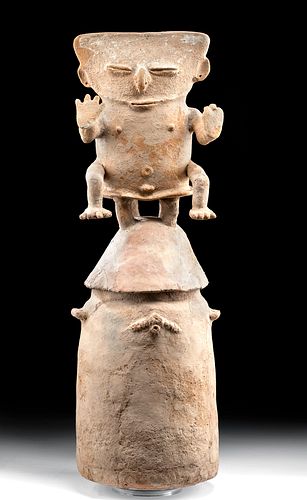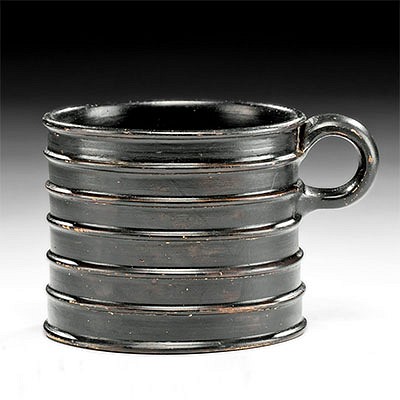Large Rio Magdalena Pottery Human Lidded Funerary Urn
Lot 106h
About Seller
Artemis Gallery
686 S Taylor Ave, Ste 106
Louisville, CO 80027
United States
Selling antiquities, ancient and ethnographic art online since 1993, Artemis Gallery specializes in Classical Antiquities (Egyptian, Greek, Roman, Near Eastern), Asian, Pre-Columbian, African / Tribal / Oceanographic art. Our extensive inventory includes pottery, stone, metal, wood, glass and textil...Read more
Estimate:
$2,800 - $4,200
Absentee vs Live bid
Two ways to bid:
- Leave a max absentee bid and the platform will bid on your behalf up to your maximum bid during the live auction.
- Bid live during the auction and your bids will be submitted real-time to the auctioneer.
Bid Increments
| Price | Bid Increment |
|---|---|
| $0 | $25 |
| $300 | $50 |
| $1,000 | $100 |
| $2,000 | $250 |
| $5,000 | $500 |
| $10,000 | $1,000 |
| $20,000 | $2,500 |
| $50,000 | $5,000 |
| $100,000 | $10,000 |
| $200,000 | $20,000 |
About Auction
By Artemis Gallery
Mar 12, 2020
Set Reminder
2020-03-12 10:00:00
2020-03-12 10:00:00
America/New_York
Bidsquare
Bidsquare : Ancient / Ethnographic Around The World
https://www.bidsquare.com/auctions/artemis-gallery/ancient-ethnographic-around-the-world-4957
Ancient art from Egypt, Greece, Italy and the Near East, as well as Asian, Fossils, Pre-Columbian, Native American, African / Tribal / Oceanic, Spanish Colonial, Russian Icons, Fine art, much more! Artemis Gallery info@artemisgallery.com
Ancient art from Egypt, Greece, Italy and the Near East, as well as Asian, Fossils, Pre-Columbian, Native American, African / Tribal / Oceanic, Spanish Colonial, Russian Icons, Fine art, much more! Artemis Gallery info@artemisgallery.com
- Lot Description
Pre-Columbian, Colombia, Lower Magdalena, Moskito, ca. 1000 to 1500 CE. A sizable male effigy lidded burial urn, hand-built via the coiling method to hold skeletal remains of a cherished ancestor. The conical lid features a seated male figure with outspread legs, hands raised in a defensive pose, a rotund body with clavicles, hip bones, a spinal column, and delineated genitalia. His angular head presents with a serene, trance-like visage bearing squinting eyes, a curved nose, a closed mouth, pierced ears, and a broad forehead. The walls of the lower vessel body feature abstract winged creatures as well as perforated lug handles. Size (w/ lid): 10.5" W x 31" H (26.7 cm x 78.7 cm).
In the valley of the River Magdalena, ancient rituals related to the preparation of the body of the deceased for its journey to the afterlife involved the practice of secondary burials in urns like this example. According to the curatorial department of the Museo del Oro Banco de la Republica, "There are two different stages in the secondary burial funerary custom: first of all a primary burial takes place, where the corpse is buried for a certain period of time established in the ritual, and then after this, it is exhumed for burial once more in an urn, possibly amidst a great collective ceremony. Urns have been found in well tombs with side chamber, with certain local and regional variations. The chambers contain between three and seventy urns, each holding charred bone remains, large fractured bones, and fragments of skull. Each is accompanied by pots, bowls and goblets, most of which were made exclusively for the dead person, for they show no signs of having been used. Spindle whorls, rollers and axes have also been found."
Scholars argue that the custom of creating burial urns is related to the association of bones with the afterlife. According to Armand Labbe's "Colombia Before Columbus," "There is a widespread belief among many Indians of both Middle and South America that bones are a form of seed, from which new life will spring. Recall the Mexican allegory of the personification of the dual lifeforce, Quetzalcoatl, descending to the underworld to retrieve the bones of mankind to resurrect them to a new life." Labbe continues, "Within the Colombian context, the act of placing bones in cylindrical, phalliform urns, and placing these in the womb-like shaft-and-chamber tomb within the Earth Mother, seems to be an enactment of such beliefs." (Labbe, "Colombia Before Columbus: The People, Culture, and Ceramic Art of Prehispanic Colombia." (1986) New York: Rizzoli, p. 116)
For a stylistically similar example with the human on the lid bearing lowered arms, please see: Labbe, Armand J. "Colombia Before Columbus: The People, Culture, and Ceramic Art of Prehispanic Colombia." Rizolli International Publications, New York, 1986, p. 117, fig. 103.
Provenance: private J.H. collection, Beaverton, Oregon, USA, acquired in September 2017; ex-Artemis Gallery; ex-private J. Smith collection, Atlanta, Georgia, USA
All items legal to buy/sell under U.S. Statute covering cultural patrimony Code 2600, CHAPTER 14, and are guaranteed to be as described or your money back.
A Certificate of Authenticity will accompany all winning bids.
We ship worldwide and handle all shipping in-house for your convenience.
#149617Repaired from multiple pieces. Figural lid shows repaired limbs, losses to tips of a few fingers and toes, peripheries of eyelids, and projecting waistline. Repairs to handles and rim of urn body. Expected surface wear with abraded areas commensurate with age. Areas of manganese deposits.Condition
- Shipping Info
-
All shipping is handled in-house for your convenience. Your invoice from Artemis Gallery will include shipping calculation instructions. If in doubt, please inquire BEFORE bidding for estimated shipping costs for individual items.
-
- Buyer's Premium



 EUR
EUR CAD
CAD AUD
AUD GBP
GBP MXN
MXN HKD
HKD CNY
CNY MYR
MYR SEK
SEK SGD
SGD CHF
CHF THB
THB















